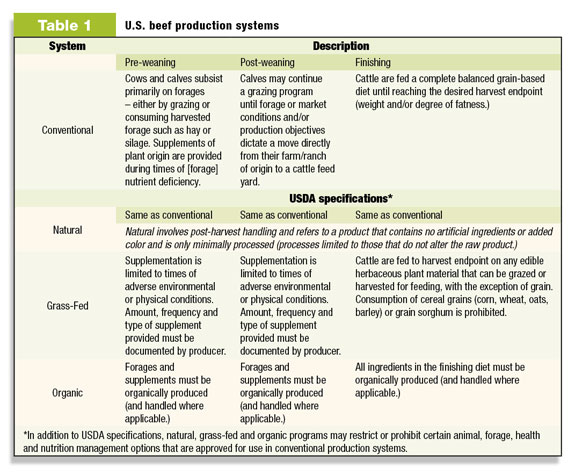Health consciousness is an ever-increasing concern – in the political, environmental, social and personal health arenas. As Americans attempt to eat healthier food, producers respond and new products appear in the marketplace – and beef is no exception.
As “natural,” “grass-fed” and “organic” beef become more visible in meat markets, on menus and in the media, producers and consumers alike have questions relative to production specifications, market potential and nutrient content.
Many of these new beef products claim nutritional or wholesomeness superiority over conventionally produced beef.
Science-based, peer-reviewed nutrition research reviews do not support such claims. Natural, grass-fed and organic beef refer to production systems that yield beef products similar in nutrient content, safety and wholesomeness to conventionally produced beef. Supporting evidence in the scientific literature includes:
Without question, food produced by American ranchers and farmers is safe and wholesome – perhaps the best in the world.
The intent of this article is to help beef producers and consumers better understand the basic similarities and differences between conventional, natural, grass-fed and organic beef production systems (see Table 1).

Conventional
Over 90 percent of domestically produced beef comes from conventional production systems – cows consuming primarily forages, their calves grazing alongside until weaning at 5 to 8 months old. Upon weaning, beef calves typically:
- Are pastured as stocker cattle in a grazing system, then moved to a feedyard for finishing as described below, or:
- Are moved directly to a feedyard for finishing on a complete, balanced, high-concentrate diet
Health management – Primary focus is on preventative health care including vaccinations and biosecurity measures.
- Antibiotic use is primarily therapeutic
- An ionophore may be fed to improve feed efficiency
- Growth-promoting implants may be used to enhance weight gain
Marketing – Auction markets remain the primary avenue for marketing feeder calves and market cows and bulls. Other options include direct sale, video or Internet offerings and retained ownership.
Natural
Many foods are described as being “natural.” To use the term “natural” on a food label, USDA requires adherence to only three specifications, all of which pertain to the post-mortem handling/processing of beef. The USDA specifications are product:
- Must be minimally processed
- Cannot contain any artificial ingredients, and
- Cannot contain any preservatives
By this definition, most fresh, conventionally produced beef qualifies as natural.
In the retail case, this definition applies to beef that does not have an ingredient label (products with marinade, tenderizer or other additives require a label). If there is no ingredient label, it is assumed the product is natural.
However, most branded beef programs have additional requirements for their specific “natural” beef products. At the present time, there are over 30 companies that purchase cattle and/or beef that qualifies as natural.
Health management – Primary focus is on preventative health care including vaccinations and biosecurity measures. Natural beef programs may have a variety of brand-specific specifications. Some examples include:
- No antibiotic use (known as “never ever” programs)
- Limited antibiotic use (known as “not lately” programs; most programs prohibit antibiotic use within the last 100 days prior to harvest.)
- Ionophore use may (or may not) be allowed
- Use of growth-promoting implants is generally not allowed
- Use of feed containing mammalian protein or fat may be restricted
Marketing – To qualify for a natural-branded program, some level of source and management verification is required. Consequently, most calves that qualify for natural beef programs are sold:
- As feeder, stocker or fed cattle through an alliance with one of the natural-branded beef programs, or
- Direct from producer to a packer, retailer or consumer
Adherence to the requirements of a natural-branded beef program is overseen and enforced by the branding company’s management or a representative thereof.
Grass-fed
Grass-fed beef has at least three definitions.
According to USDA the term “grass-fed” applies to “ruminant animals and the meat and meat products derived from such animals whose diet, throughout their lifespan, with the exception of milk (or milk replacer) consumed prior to weaning, is solely derived from forage which, for the purpose of this claim, is any edible herbaceous plant material that can be grazed or harvested for feeding, with the exception of grain.
“Animals cannot be fed grain or grain products and must have continuous access to pasture during the growing season.
“Hay, haylage, baleage, silage, crop residue without grain and other roughage sources may also be included as acceptable feed sources.
Consumption of seeds naturally attached to forage is acceptable. However, crops normally harvested for grain (including but not limited to corn, soybean, rice, wheat and oats) are only eligible if they are foraged or harvested in the vegetative state (pre-grain).
“Routine vitamin and mineral supplementation may also be included in the feeding regimen. If incidental supplementation occurs due to inadvertent exposure to non-forage feedstuffs or to ensure the animal’s well-being at all times during adverse environmental or physical conditions, the producer must fully document the supplementation that occurs including the amount, frequency and the supplements provided.”
The American Grass-fed Association (AGA) further defines their products:
- Animals having been, from birth to harvest, fed on grass, legumes and forages, and
- Animals having not been: creep-fed as calves, fed for extended periods in confinement or finished on grains.
AGA further defines beef products according to a three-tier system. AGA grass-fed and pasture- finished cattle “must be maintained at all times on range, pasture or in paddocks with at least 75 percent forage cover or unbroken ground for their entire lives.” Further, such cattle “cannot be fed stockpiled forages in confinement for more than 30 days per calendar year.”
- Tier 1 – Animals must be maintained on 100 percent forage diets with no exposure to any non-forage supplements
- Tier 2 – Animals may only be fed approved non-forage supplements to ensure the animal’s well-being during periods of low forage quality or inclement weather
- Tier 3 – Pasture-finished cattle may be fed approved non-forage supplements at a rate of 0.5 percent of bodyweight during the growth stage and 1.0 percent of bodyweight (DM basis) during the finishing phase. Here, finishing is defined as the last 200 pounds gained before harvest.
The National Cattleman’s Beef Association defines grass-finished beef as “that produced from cattle that grazed pastures their entire lives.”
Health management – Primary focus is on preventative health care including vaccinations and biosecurity measures. Most grass-fed programs specify:
- No therapeutic or sub-therapeutic antibiotic use (a “never ever” program)
- No growth-promoting implants
- No ionophores
Cattle that are injured or become ill typically receive therapeutic antibiotic treatment and are marketed as conventionally produced beef.
From an animal well-being standpoint, it is critical that cattle (in these non-conventional production systems) which become ill, injured or burdened with internal and/or external parasites be treated in a timely manner and with the most effective product, regardless of whether or not the treatment will prevent them from being retained in these branded programs.
Marketing – Forage-fed cattle grow slower than similar cattle in a conventional system. Consequently, most grass-fed cattle are harvested at an older age and a lower weight than those in a conventional or natural production system.
Carcass fat will likely not be bleached white in color. Depending on the quality and type of forage grazed during the 120 days immediately preceding harvest, carcass fat may be from pearl white to yellow (beta carotene from green forages is stored in fat tissue).
Whole muscle cut size and dimension may be different than conventional or natural beef, due primarily to the lower harvest weights.
Marketing – To qualify for a grass-fed branded program, source and management verification is required. Consequently, most cattle that qualify as grass-fed beef are sold direct from the producer to a:
- Packer
- Wholesaler
- Retailer or
- Consumer
Compliance with the requirements of a grass-fed beef program are often monitored by on-farm/ranch visits and audits performed by the affiliated marketing alliance or a certifying agency.
Organic
Organic beef production and marketing is defined by USDA standards developed for all food labeled as “organic.”
Organic beef production requires more time, effort and documentation than the other production systems described herein.
Livestock production and handling standards, outlined in USDA’s National Organic Program (NOP) include:
- Animals for slaughter must be raised under USDA-certified organic management from the last third of gestation to harvest.
- Diets must contain feedstuffs that are certifiably 100 percent organic. Forages, cereal grains and oilseeds (ex., cotton, canola, soybean) must be grown without the use of synthetic fertilizers, herbicides or pesticides. Initially, organic crop production is preceded by a three-year period of abstaining from the use of “prohibited substances” (for a list, see National Organic Program standards). Preference will be given to the use of organic seeds and planting stocks. Nonorganic seeds/stock may be used in specific instances and with NOP approval. Use of genetically modified (GMO) crops is prohibited.
- Dietary vitamin and mineral supplements are allowed as warranted.
- Use of growth promotants or antibiotics (for any reason) is strictly prohibited.
- Organically produced cattle must have access to the outdoors, including access to pasture. Daily intake requirements call for a minimum of 30 percent of their daily intake come from standing forages during the growing season. Temporary confinement is allowed for reasons of health, safety, stage of production or to protect soil or water quality.
- Animals must be processed and handled under USDA certification.
Health management – Primary focus is on preventative health care including vaccinations and biosecurity measures.
According to NOP standards, producers must not withhold treatment from a sick or injured animal; however, animals treated with a prohibited medication may not be sold as organic.
Upon recovery, treated cattle are marketed as conventionally produced beef.
Although not specifically addressed in the NOP standards, concerns over animal welfare issues are growing due to inadequate control of internal and particularly external parasites in some organic production systems.
Marketing – As mentioned above, cattle must be processed and handled under USDA certification, from the last third of gestation to consumer purchase.
Consequently, organic beef moves from farm or ranch of origin through a well-defined, traceable, certifiable processing, handling and marketing chain.
Within Texas, the USDA’s National Organic Program (NOP) is managed and audited by the Texas Department of Agriculture, Organic Certification Program.
Summary
Beef producers considering a different production system should carefully consider the options and their respective requirements.
Like breeds of cattle, it is not (and need not) be “one kind fits all” when it comes to producing beef.
The current trend in consumer preferences indicates continued growth in demand for natural, grass-fed and organic beef products; no doubt, the availability of such products has resulted in the retention of beef consumers that would otherwise have abandoned beef as their source of animal protein. Long-term success of the U.S. beef industry depends on customers repeatedly voting on beef with their food dollars.
However, promotion of any one product at the expense of beef from the other production systems is not in the best interest of the U.S. beef industry.
—Excerpts from 2010 TAMU Beef Cattle Short Course
Most “natural” beef labels mean the beef is minimally processed, has no artificial ingredients and contains no preservatives. Photo by David Cooper.







